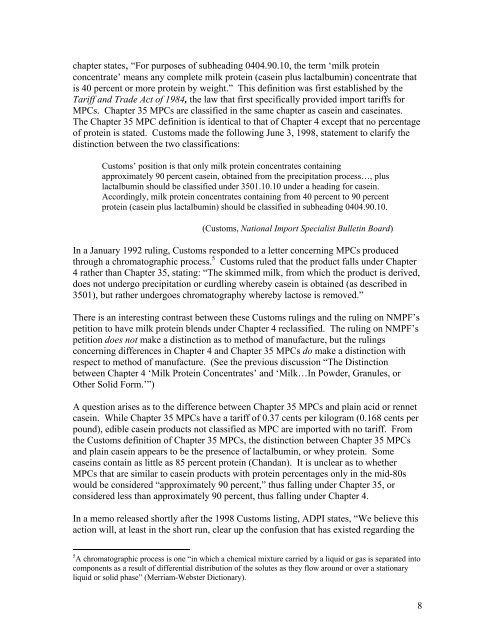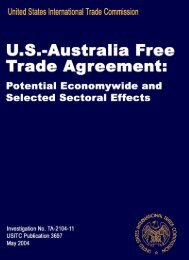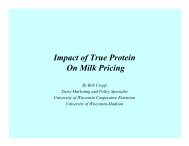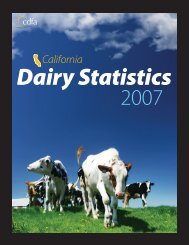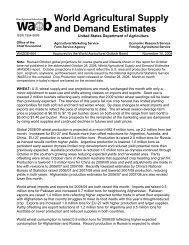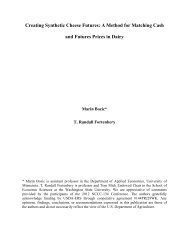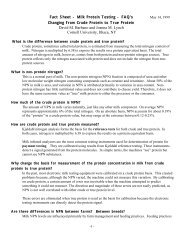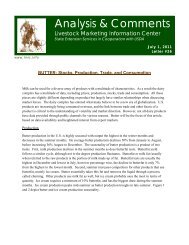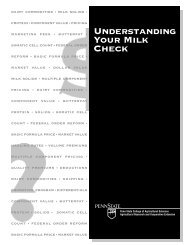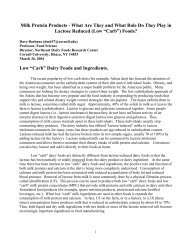Milk Protein Products and Related Government Policy Issues
Milk Protein Products and Related Government Policy Issues
Milk Protein Products and Related Government Policy Issues
You also want an ePaper? Increase the reach of your titles
YUMPU automatically turns print PDFs into web optimized ePapers that Google loves.
chapter states, “For purposes of subheading 0404.90.10, the term ‘milk protein<br />
concentrate’ means any complete milk protein (casein plus lactalbumin) concentrate that<br />
is 40 percent or more protein by weight.” This definition was first established by the<br />
Tariff <strong>and</strong> Trade Act of 1984, the law that first specifically provided import tariffs for<br />
MPCs. Chapter 35 MPCs are classified in the same chapter as casein <strong>and</strong> caseinates.<br />
The Chapter 35 MPC definition is identical to that of Chapter 4 except that no percentage<br />
of protein is stated. Customs made the following June 3, 1998, statement to clarify the<br />
distinction between the two classifications:<br />
Customs’ position is that only milk protein concentrates containing<br />
approximately 90 percent casein, obtained from the precipitation process…, plus<br />
lactalbumin should be classified under 3501.10.10 under a heading for casein.<br />
Accordingly, milk protein concentrates containing from 40 percent to 90 percent<br />
protein (casein plus lactalbumin) should be classified in subheading 0404.90.10.<br />
(Customs, National Import Specialist Bulletin Board)<br />
In a January 1992 ruling, Customs responded to a letter concerning MPCs produced<br />
through a chromatographic process. 5 Customs ruled that the product falls under Chapter<br />
4 rather than Chapter 35, stating: “The skimmed milk, from which the product is derived,<br />
does not undergo precipitation or curdling whereby casein is obtained (as described in<br />
3501), but rather undergoes chromatography whereby lactose is removed.”<br />
There is an interesting contrast between these Customs rulings <strong>and</strong> the ruling on NMPF’s<br />
petition to have milk protein blends under Chapter 4 reclassified. The ruling on NMPF’s<br />
petition does not make a distinction as to method of manufacture, but the rulings<br />
concerning differences in Chapter 4 <strong>and</strong> Chapter 35 MPCs do make a distinction with<br />
respect to method of manufacture. (See the previous discussion “The Distinction<br />
between Chapter 4 ‘<strong>Milk</strong> <strong>Protein</strong> Concentrates’ <strong>and</strong> ‘<strong>Milk</strong>…In Powder, Granules, or<br />
Other Solid Form.’”)<br />
A question arises as to the difference between Chapter 35 MPCs <strong>and</strong> plain acid or rennet<br />
casein. While Chapter 35 MPCs have a tariff of 0.37 cents per kilogram (0.168 cents per<br />
pound), edible casein products not classified as MPC are imported with no tariff. From<br />
the Customs definition of Chapter 35 MPCs, the distinction between Chapter 35 MPCs<br />
<strong>and</strong> plain casein appears to be the presence of lactalbumin, or whey protein. Some<br />
caseins contain as little as 85 percent protein (Ch<strong>and</strong>an). It is unclear as to whether<br />
MPCs that are similar to casein products with protein percentages only in the mid-80s<br />
would be considered “approximately 90 percent,” thus falling under Chapter 35, or<br />
considered less than approximately 90 percent, thus falling under Chapter 4.<br />
In a memo released shortly after the 1998 Customs listing, ADPI states, “We believe this<br />
action will, at least in the short run, clear up the confusion that has existed regarding the<br />
5 A chromatographic process is one “in which a chemical mixture carried by a liquid or gas is separated into<br />
components as a result of differential distribution of the solutes as they flow around or over a stationary<br />
liquid or solid phase” (Merriam-Webster Dictionary).<br />
8


